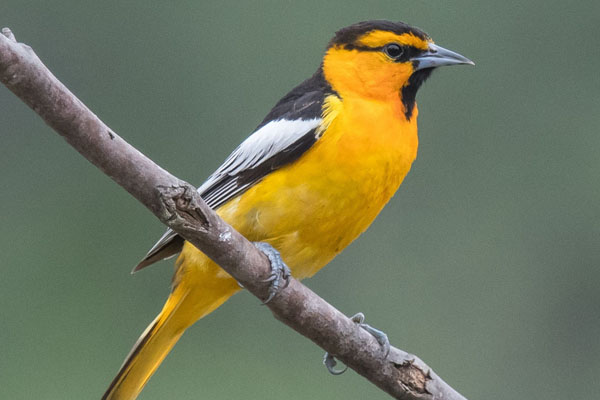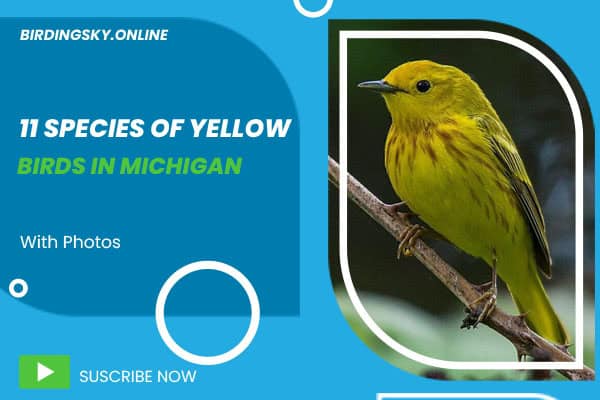Have you ever wondered about the vibrant yellow birds that grace the landscapes of Michigan? The Great Lakes State is home to a diverse array of these feathered wonders, each with its own unique features and behaviors. In this comprehensive guide, we’ll explore 11 stunning species of yellow birds that you can spot in Michigan, from the iconic American goldfinch to the elusive yellow-breasted chat. Discover the vibrant residents and occasional visitors that add a touch of sunshine to the state’s natural wonders.
Main Points:
- Michigan is home to a diverse array of yellow bird species, each with its own unique characteristics.
- The American goldfinch is the most well-known and beloved yellow bird in the state.
- Other remarkable yellow birds include the yellow-breasted chat and the Townsend’s warbler.
- Seasonal visitors like the Bullock’s oriole and the western tanager add a touch of tropical flair to Michigan’s avian diversity.
- Rare and unexpected species, such as the worm-eating warbler, can also be spotted in the state.
Introducing the Vibrant World of Yellow Birds in Michigan
The allure of yellow birds in Michigan is undeniable, with their striking plumage and vibrant hues that seem to radiate warmth and joy. These feathered wonders thrive in a diverse array of habitats across the Great Lakes State, from lush forests and dense shrublands to sprawling wetlands and urban parks. Each species has adapted to its unique ecosystem, offering birdwatchers a chance to witness the remarkable diversity of Michigan’s avian life.
The Allure of Brilliant Plumage
The captivating beauty of yellow birds in Michigan lies in their stunning plumage, which can range from subtle shades of lemon to vibrant golden hues. These vibrant feathers not only serve as a visual delight but also play a crucial role in the birds’ courtship rituals and communication within their respective ecosystems.
Michigan’s Diverse Avian Ecosystems
The state of Michigan is home to a diverse array of bird habitats, each supporting a unique assemblage of yellow bird species. From the dense foliage of northern forests to the lush wetland environments, these habitats provide the necessary resources and shelter for Michigan’s yellow birds to thrive. By exploring these diverse ecosystems, birdwatchers can uncover the remarkable adaptations and behaviors of the yellow bird species that call Michigan home.
The American Goldfinch: Michigan’s Iconic Yellow Bird
The American goldfinch is undoubtedly the most well-known and beloved yellow bird in Michigan. With its brilliant yellow plumage, black cap, and distinctive flight pattern, the American goldfinch is a true icon of the state’s avian landscape.

Identifying the American Goldfinch
The American goldfinch is a small, stocky finch with a short, conical bill. Its most distinctive feature is its bright yellow body, which contrasts sharply with its black cap, wings, and tail. During the winter months, the male American goldfinch loses its vibrant yellow hue, taking on a more subdued olive-green tone, but its black cap and wings remain. Females and juveniles maintain a more muted yellow-green plumage year-round.
Nesting Habits and Diet
The American goldfinch is a unique species in that it nests and breeds much later in the season compared to other songbirds. These birds typically construct their nests in late summer, using soft materials such as thistle down, grass, and animal fur. The American goldfinch diet consists primarily of seeds, with a particular fondness for the seeds of thistles, sunflowers, and other composite flowers. This helps to explain their delayed nesting, as they wait for these seed-bearing plants to mature before starting their families.
The American goldfinch‘s enduring presence in Michigan is a testament to its adaptability and the abundance of suitable habitats throughout the state. Whether you’re birdwatching in urban parks, rural woodlands, or along the shores of the Great Lakes, keep an eye out for this vibrant, iconic species that brightens up the Michigan landscape.
Yellow Birds in Michigan
Beyond the beloved American goldfinch, Michigan is home to a remarkable diversity of yellow birds, each with its own unique characteristics and behaviors. In this section, we’ll introduce you to the elusive yellow-breasted chat, a vocal marvel known for its extensive repertoire of calls and songs, as well as the Townsend’s warbler, a western migrant that occasionally graces the state with its presence, delighting birdwatchers with its striking plumage.
The Yellow-Breasted Chat: A Vocal Delight

The yellow-breasted chat is a unique and captivating member of the Michigan avian community. This secretive bird is known for its diverse vocal abilities, producing a wide range of calls and songs that can include whistles, chuckles, and even mimicry of other species. Despite its elusive nature, the yellow-breasted chat is a true treat for those who are fortunate enough to spot it in its preferred habitats, such as dense shrublands and forest edges.
The Townsend’s Warbler: A Western Migrant
While not a permanent resident of Michigan, the Townsend’s warbler is an occasional visitor to the state, delighting birdwatchers with its striking appearance. This western species is characterized by its bright yellow face, black throat, and olive-green back, creating a stunning contrast that is sure to capture the attention of any bird enthusiast. The Townsend’s warbler is often observed during its spring and fall migrations, offering a fleeting but memorable glimpse of this remarkable yellow bird species.
Bullock’s Oriole: A Splash of Orange and Black
While not a year-round resident, the Bullock’s oriole is a stunning visitor to Michigan, captivating observers with its vibrant blend of orange and black plumage. This western species is a true standout, adding a touch of tropical flair to the state’s avian diversity. In this section, we’ll explore the key features and migratory patterns of the Bullock’s oriole and its occasional appearances in Michigan.

The Bullock’s oriole is a member of the oriole family, known for its striking appearance and distinctive call. With a bold black head, back, and wings, paired with a brilliant orange breast and belly, this bird is a true showstopper. Its long, pointed beak and graceful movements add to its overall elegance. During the breeding season, the Bullock’s oriole can be found nesting in tall trees and shrubs, often near open areas or water sources.
While the Bullock’s oriole is primarily a resident of the western United States, it occasionally ventures eastward, with some individuals making their way to Michigan. These appearances are typically during the spring and summer months, as the birds migrate to their breeding grounds. Birdwatchers in the Michigan region eagerly await the arrival of this yellow bird species, which adds a vibrant splash of color to the local oriole population.
| Feature | Description |
|---|---|
| Plumage | Bright orange breast and belly, black head, back, and wings |
| Beak | Long, pointed, and sharp |
| Habitat | Breeds in tall trees and shrubs, often near open areas or water |
| Migration | Occasional visitor to Michigan during spring and summer |
The appearance of the Bullock’s oriole in Michigan is a true delight for birdwatchers, adding a vibrant splash of color to the state’s yellow bird population. While its visits may be fleeting, these striking birds leave a lasting impression on all who are fortunate enough to catch a glimpse of their stunning plumage.
The Western Tanager: A Fiery Visitor
Another dazzling yellow bird that graces Michigan with its presence is the western tanager. With its fiery red head, bright yellow body, and black wings, this species is a true sight to behold.
Distinguishing the Western Tanager
The western tanager is a stunning bird, easily identifiable by its vibrant plumage. Its distinctive red head, contrasted by the black wings and tail, makes it a standout among Michigan‘s yellow bird species. The bright yellow body, with its subtle olive hues, adds to the bird’s captivating appearance, making it a favorite among birdwatchers when it appears in the state.
Migration Patterns and Breeding Grounds
The western tanager is not a permanent resident of Michigan, but rather a visitor that arrives during its seasonal migration. These birds breed in the western regions of North America, primarily in coniferous forests, before embarking on their journey eastward. Michigan is often graced with the presence of the western tanager as it travels to and from its breeding grounds, offering birdwatchers a chance to catch a glimpse of this fiery feathered wonder.
Painted Bunting: A Tropical Treat
While not a regular resident of Michigan, the painted bunting is a true tropical treat that has been known to make appearances in the state. With its stunning multicolored plumage, the painted bunting is a sight that captivates birdwatchers. In this section, we’ll explore the key identifying features of this species and discuss the conservation efforts that aim to protect this remarkable bird’s populations.
Identifying the Painted Bunting
The painted bunting is a truly unique and visually striking bird. Its vibrant plumage features a stunning combination of red, blue, green, and yellow hues, making it one of the most colorful songbirds in North America. Identifying the painted bunting can be a thrilling experience for birdwatchers, as its distinct appearance sets it apart from other yellow birds found in Michigan.
Check Our Previous Posts:
| Spiritual Meanings of Blackbirds |
| 12 Types Of Red Birds in Michigan |
| Spotting 4 Types Of Doves in Indiana |
| Explore 12 TYPES OF BLACKBIRDS |
Breeding and Conservation Efforts
Despite its captivating appearance, the painted bunting faces conservation challenges. As a migratory species, the painted bunting is vulnerable to habitat loss and environmental threats along its breeding and wintering grounds. Conservation organizations and researchers are working to better understand the painted bunting‘s breeding behavior and population dynamics, with the goal of implementing effective strategies to protect this vibrant bird’s future.
| Key Identification Features | Breeding Habitat | Conservation Status |
|---|---|---|
| Multicolored plumage: red, blue, green, and yellow | Shrublands, woodland edges, and suburban areas | Least Concern, but populations have declined in some regions |
Worm-Eating Warbler and Other Occasional Visitors
While the vibrant yellow birds we’ve explored so far are relatively common sights in Michigan, the state is also home to a few more elusive and occasional visitors. One such species is the worm-eating warbler, a unique yellow bird known for its distinctive head pattern.
The worm-eating warbler is a rare treat for birdwatchers in Michigan, as it typically resides in the eastern United States and is not a regular resident of the Great Lakes State. With its olive-green upperparts, yellow underparts, and striking black and tan head stripes, this warbler’s appearance is truly one-of-a-kind. Catching a glimpse of this species in Michigan’s forests and woodlands is a true delight for avid birders.
Beyond the worm-eating warbler, Michigan may also play host to other unexpected yellow bird visitors. The state’s diverse habitats and geographic location can attract occasional sightings of rare or unusual yellow species, such as the Townsend’s warbler or the vibrant painted bunting. These rare encounters offer birdwatchers the opportunity to add unique feathered friends to their Michigan checklists, making each outing an exciting adventure.


Add comment